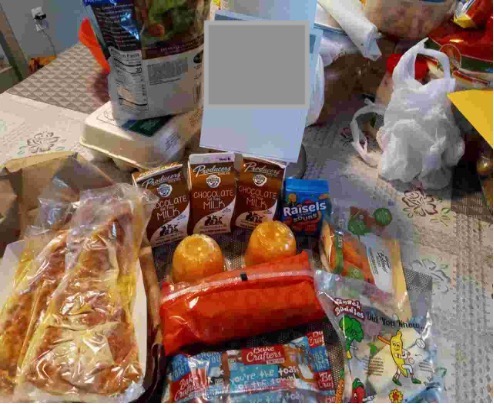Back
Health Equity/Social Determinants of Health
Category: Abstract Submission
Health Equity/Social Determinants of Health II
92 - Parent Perception of Quality, Appeal, and Healthfulness of School Meals in the San Joaquin Valley during COVID-19: A Photovoice Project
Saturday, April 23, 2022
3:30 PM – 6:00 PM US MT
Poster Number: 92
Publication Number: 92.211
Publication Number: 92.211
Tatum M. Sohlberg, Stanford University School of Medicine, Palo Alto, CA, United States; Emma Higuchi, Stanford University, Los Angeles, CA, United States; Valeria Ordonez, Stanford University School of Medicine, Palo Alto, CA, United States; Ashley de la Rosa, Dolores Huerta Foundation, Bakersfield, CA, United States; Gabriela V. Escobar, Stanford University School of Medicine, San Jose, CA, United States; Cecilia A. Castro, Dolores Huerta Foundation, Bakersfield, CA, United States; Genoveva Islas, CULTIVA LA SALUD, Fresno, CA, United States; Kenneth N. Hecht, UC Nutrition Policy Institute, Berkeley, CA, United States; Christina Hecht, University of California, Nutrition Policy Institute, Oakland, CA, United States; Janine Bruce, Stanford University School of Medicine, Stanford, CA, United States; Anisha I. Patel, Stanford University School of Medicine, Palo Alto, CA, United States

Tatum M. Sohlberg, MD, MPH
Pediatrics Resident
Stanford University School of Medicine
Palo Alto, California, United States
Presenting Author(s)
Background: School-based nutrition programs are crucial to reducing food insecurity, which is associated with adverse health effects in children. However, the COVID-19 pandemic has adversely impacted students’ school meal participation. Schools transitioned to primarily providing take-home meals during the pandemic, and for many parents this was the first time they saw food provided by schools.
Objective: This study seeks to understand parent views of school meals during COVID-19 to inform advocacy efforts to improve participation in school meal programs.
Design/Methods: A partnership among two community-based organizations in California's San Joaquin Valley (SJV) and two academic institutions used photovoice methodology to explore parental perception of school meals and their child’s participation in the school meal program. Parents in seven school districts in SJV photographed school meals following a set protocol for a one-week period during the pandemic, and then parents participated in focus groups to discuss their photographs. Focus groups were transcribed, and data were analyzed using a team-based theme analysis approach. Findings have been shared with parent participants who validated themes.
Results: Thirty-eight parents participated in photo-taking and 27 attended one of seven focus groups conducted in English and Spanish. Three primary domains emerged from focus group analysis: benefits of school meal distribution, meal quality and appeal, and perceived healthfulness. Parents expressed gratitude for availability of meals, but perceived school meals as including unappealing food that was high in added sugar and lacking nutrition (Figure 1 and 2). They felt this led to decreased participation in the school meal program and discarded meals.Conclusion(s): The transition to grab-and-go style meals was an effective strategy for providing food to families during pandemic school closures and school meals remain an important resource for families experiencing food insecurity. However, negative parental perceptions of the appeal and nutritional content of school meals may have led to decreased school meal participation and wasted food that could persist beyond the pandemic.
California just became the first state in the nation to offer two free school meals daily to all children regardless of income, to start in School Year 2022-23. Study findings suggest that improvements of appeal of school meals and placing limits on added sugar could improve parent perceptions of meals and optimize participation in the universal school meal program, thereby reducing food insecurity.
Sohlberg CVSohlberg CV.pdf
Figure 2 Photograph of meal including shrink-wrapped pizza slice that was not appealing to children.
Photograph of meal including shrink-wrapped pizza slice that was not appealing to children.
Objective: This study seeks to understand parent views of school meals during COVID-19 to inform advocacy efforts to improve participation in school meal programs.
Design/Methods: A partnership among two community-based organizations in California's San Joaquin Valley (SJV) and two academic institutions used photovoice methodology to explore parental perception of school meals and their child’s participation in the school meal program. Parents in seven school districts in SJV photographed school meals following a set protocol for a one-week period during the pandemic, and then parents participated in focus groups to discuss their photographs. Focus groups were transcribed, and data were analyzed using a team-based theme analysis approach. Findings have been shared with parent participants who validated themes.
Results: Thirty-eight parents participated in photo-taking and 27 attended one of seven focus groups conducted in English and Spanish. Three primary domains emerged from focus group analysis: benefits of school meal distribution, meal quality and appeal, and perceived healthfulness. Parents expressed gratitude for availability of meals, but perceived school meals as including unappealing food that was high in added sugar and lacking nutrition (Figure 1 and 2). They felt this led to decreased participation in the school meal program and discarded meals.Conclusion(s): The transition to grab-and-go style meals was an effective strategy for providing food to families during pandemic school closures and school meals remain an important resource for families experiencing food insecurity. However, negative parental perceptions of the appeal and nutritional content of school meals may have led to decreased school meal participation and wasted food that could persist beyond the pandemic.
California just became the first state in the nation to offer two free school meals daily to all children regardless of income, to start in School Year 2022-23. Study findings suggest that improvements of appeal of school meals and placing limits on added sugar could improve parent perceptions of meals and optimize participation in the universal school meal program, thereby reducing food insecurity.
Sohlberg CVSohlberg CV.pdf
Figure 2
 Photograph of meal including shrink-wrapped pizza slice that was not appealing to children.
Photograph of meal including shrink-wrapped pizza slice that was not appealing to children.